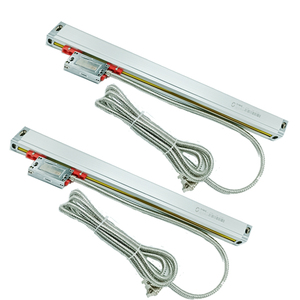(521 products available)
























































































































































































There are mainly two important types of linear encoders. They then subdivide into some categories. These encoders are very important for accuracy. They also promote speed when doing operations on the CNC milling machines.
These encoders give the zero position and the distance moved as electrical signals. They use mark stripes on the measuring rods. These stripes generate signals as the reader head moves along the rod. The signals are then compared with each other. The comparison of the signals helps to know the machine's movement. The position is got by counting the signals. The final count gives the increment of movement from the home position. A
They give exact position readings even when the machine is not moving. They work by using a unique coded disc or strip for every position along the path. They supply information as the axial or radial permanent magnets interact with sensors fixed in the stator blades.
What makes these encoders more desirable is the fact that they always give accurate states of position even after electric power disconnection. There is no need to search for the encoder's home position when power is restored. This makes them suitable for use in CNC machinery where efficacy is more desirable and sought after.
The functionality and durability of linear encoders greatly depend on their internal and external components. These components are constructed from different materials.
It can either be glass, steel, or plastic. Glass strips are used for absolute linear encoders. They provide a high degree of accuracy. The cost of glass makes it suitable for high-end applications only.
Steel measuring strips are robust and very durable when used in industrial operations. The strips also possess magnetic properties. This makes them ideal for use with magnetic sensors. On the other hand, plastic strips are lightweight. However, they are less accurate and suitable for use in low-demand areas only.
These housings are made of aluminum, plastic, or stainless steel. Aluminum is lightweight and strong enough to protect sensitive parts from environmental harm. Plastic casings are lightweight and less expensive. However, they do not provide good protection in industrial areas. Stainless steel houses are very durable in CNC milling machines working in harsh environments.
These components are normally manufactured from different types of materials. They include glass, metals, and plastics. These materials form sensors in optical encoders. Optical sensor components are glass to enhance accuracy. Metals enhance strength. Plastics reduce costs.
Linear encoders play a very important role in the operation of CNC machines. They improve the accuracy of machine operations and hence productivity. They also reduce dependence on manual procedures. This saves time, labor, and costs.
The accuracy and speed offered by linear encoders directly boost productivity. This helps many businesses to increase their operations within a given time period.
Since linear encoders reduce manual adjustment, there is a reduction in labor costs. This encodes the operation of CNC machines with highួន efficiency and low manual needs.
High accuracy basically means there is a very low chance of material wastage during production.
The way CNC machines are fitted with linear encoders helps in bringing effective utilization of resources. This then translates into cost savings in the long run.
These encoders reduce the time taken to set up machines manually. They also minimize errors during machining. Thus, providing an important competitive advantage for industries. It enables them to operate faster with more accuracy compared to rivals.
Manufacturers prefer linear encoders because they improve the quality of products as well as increase production rates. In sectors that require high precision, such as aerospace, automotive, and medical devices, their importance cannot be overstated.
Purchasing linear encoder kits in large quantities requires careful consideration. The following factors/suggestions help in ensuring the encoders obtained will meet the business needs as well as the demands of the customers.
A1: Linear encoders improve precision by giving exact positions during machining. This reduces mistakes and speeds up operations. They allow the CNC machine to work quickly and accurately, which is good for making parts in big factories or complex spaces.
A2: No, not all CNC milling machines have linear encoders. They are more common in machines for making parts that need very fine work, like in the medical or aerospace industries. Most normal CNC machines for light work do not need encoders.
A3: Linear encoders need very little care if they are used in clean places. They should be checked often for marks, dust, or other things that could block them. If they are in machines that make parts of cars or big machines, they should be cleaned more often.
A4: It is not good to use linear encoders outside. Wind, water, and strong temperatures can damage them. If one has to use them outside, then it is advisable to put them in strong, weather-proof covers.
A5: Linear encoders help CNC machines last longer by giving them precise positions and smooth moves. This cuts down wear on the machine's parts, allowing them to work more effectively for a longer time. The encoders also help the machine operate better, which makes the whole CNC setup work more effectively and last longer.